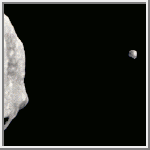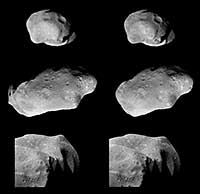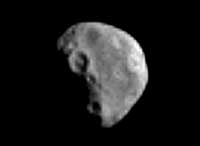













|
| Ida |
|---|
Ida is a heavily cratered, irregularly shaped asteroid in the main asteroid belt between Mars and Jupiter -- the 243rd asteroid to be discovered since the first one was found at the beginning of the 19th century. Ida is placed by scientists in the S class (stony or stony iron meteorites). It is a member of the Koronis family, which scientists believe was created when a larger body perhaps 200 to 300 kilometers (120 to 180 miles) in diameter was smashed relatively recently -- at least considerably after the solar system formed some 4.5 billion years ago.
On August 28, 1993 Galileo came within 2,400 kilometers (1,500 miles) of 243 Ida, the second asteroid ever encountered by a spacecraft. They passed each other at a relative velocity of 12.4 km/sec (28,000 mph). At the time of the encounter, Ida and Galileo were 441 million kilometers (274 million miles) from the Sun.
Ida is about 56 x 24 x 21 kilometers (35 x 15 x 13 miles) in size, more than twice as large as Gaspra. It has a period of rotation of 4 hours, 38 minutes. Its density has been estimated to be between 2.2 and 2.9 grams per cubic centimeter. Ida's age is somewhat baffling. Its surface is heavily cratered suggesting that it has existed in its present form for at least a billion years and perhaps much longer. It is also considerably older than estimates for the Koronis breakup.
| Dactyl |
|---|
The greatest discovery from the Galileo fly-by was that Ida has a natural satellite. Although Galileo flew past Ida in August 1993, the discovery wasn't made until late in February 1994 when images stored on the spacecraft's tape recorder were finally transmitted to Earth. The moon has been named Dactyl by the International Astronomical Union.
Dactyl is the first natural satellite of an asteroid ever discovered and photographed. The tiny moon is about 1.2 by 1.4 by 1.6 km (0.75 by 0.87 by 1 mile) across. The name is derived from the Dactyli, a group of mythological beings who lived on Mount Ida. The Dactyli protected the infant Zeus after the nymph Ida hid and raised the god on the mountain. Other mythological accounts say that the Dactyli were Ida's children by Zeus.
Dactyl is made more or less from the same kind of material as Ida. As an S-type asteroid, Ida is composed mostly of silicate rocks. Galileo scientists believe the moon may have been created at the same time as Ida when an older, larger asteroid was shattered in a collision with another asteroid, giving birth to dozens of smaller asteroids. Alternatively, it is possible that Ida was hit by a smaller object even more recently, leaving a crater on the asteroid and throwing off the material that became the small moon.
Galileo scientists also believe it is virtually impossible that the moon is a captured object, something created completely separately from Ida that happened to wander near the asteroid and be caught by its gravitational field. According to the laws of celestial mechanics, such an event would deflect the smaller object, but it would not be captured into orbit unless a third force of some kind slowed it down.
| Animation & VRML of Ida |
|---|
| Views of Ida and Dactyl |
|---|
 Ida & Dactyl in Color
Ida & Dactyl in Color
This color picture is made from images taken by the Galileo spacecraft
about 14 minutes before its closest approach to Ida at a range of about
10,500 kilometers (6,500 miles). The color is enhanced in the sense that
the camera is sensitive to near-infrared wavelengths of light beyond
human vision; a natural color picture of this asteroid would appear
mostly gray.
There are brighter areas, appearing bluish in the picture, around
craters on the upper left end of Ida, around the small bright crater
near the center of the asteroid and near the upper right-hand edge (the
limb). This suggests a difference in the abundance of or composition of
iron-bearing minerals in these areas. Ida's moon also has a different
color in the violet than any area on this side of Ida.
(Courtesy NASA/JPL)
 Ida
Ida
This view of the asteroid 243 Ida was acquired by the Galileo spacecraft
at ranges of 3,057 to 3,821 kilometers (1,900 to 2,375 miles) on August
28, 1993, about 3.5 minutes before the spacecraft made its close
approach to the asteroid. This view shows numerous craters, including
many degraded craters larger than any seen on Gaspra. The south pole is
believed to be in the dark side near the middle of the asteroid.
(Courtesy NASA/JPL)
 Ida and Dactyl
Ida and Dactyl
This image is the first full picture showing both asteroid 243 Ida and
its moon Dactyl transmitted to Earth from NASA's Galileo spacecraft.
Ida is the large object to the left and Dactyl is the small object to
the right. This portrait was taken about 14 minutes before Galileo's
closest approach to the asteroid, from a range of 10,870 kilometers
(6,755 miles). Although Dactyl appears to be next to Ida, it is actually
slightly in the foreground, closer to the spacecraft than Ida and is
about 100 kilometers (60 miles) away from the center of Ida.
(Courtesy NASA/JPL)
 Three Stereo Views of Ida
Three Stereo Views of Ida
This image shows three different stereo image pairs of Ida. They were
acquired by the Galileo spacecraft during its
approach to Ida. The top image pair is the lowest resolution and the
bottom image the highest. The stereo, three-dimensional view can been seen
by looking at the left image with the left eye and the right image
with the right eye. Print a small version of the image on a page, hold
the page close to your face, relax your eyes as if you were looking in
the distance, and slowly move the page away from your eyes. The image
pairs will merge together to become one image. It may take some
practice to see the images in stereo.
(Copyright © 1997 by Calvin J. Hamilton)
 Dactyl
Dactyl
This image is the most detailed picture of Dactyl taken by the Galileo
spacecraft's camera. The camera fortuitously captured the previously
unknown moon at a range of about 3,900 kilometers (2,400 miles), just
over 4 minutes before the spacecraft's closest approach to Ida. More
than a dozen craters larger than 80 meters (250 feet) in diameter are
clearly evident, indicating that Dactyl has suffered numerous collisions
from smaller solar system debris during its history. The larger crater
on the terminator is about 300 meters
(1,000 feet) across. At the time this picture was taken, Ida was about 90
kilometers (56 miles) away from the moon, outside this frame to the left
and slightly below center. (Courtesy NASA/JPL)
 Topographic Map of Ida
Topographic Map of Ida
This is a topographic map of Ida. It is based upon the shape model of
Peter Thomas and his colleagues. It was adapted by Phil Stooke and unlike
other small body models, it is quite certain.
(Courtesy A. Tayfun Oner)
| References |
|---|
Beatty, J. Kelly, "Ida & Company," Sky & Telescope, 20-23, January 1995.
Copyright © 1997-2000 by Calvin J. Hamilton. All rights reserved. Privacy Statement.